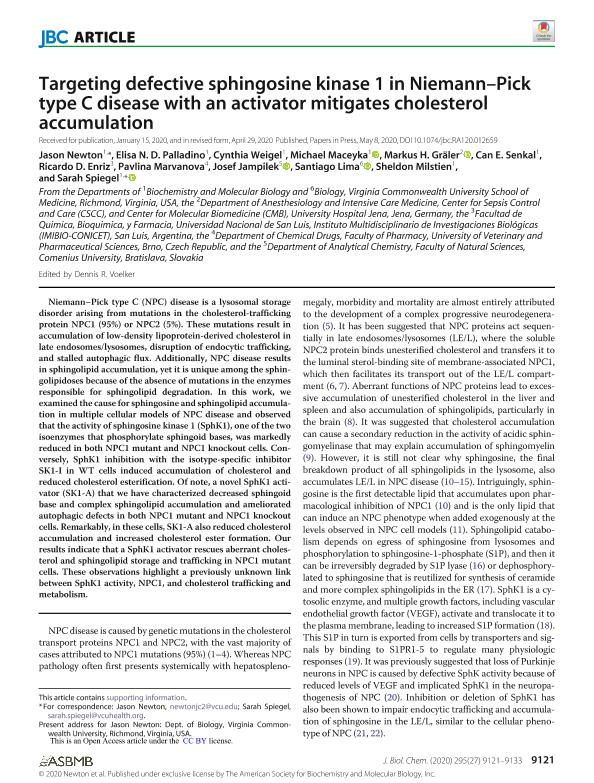Mostrar el registro sencillo del ítem
dc.contributor.author
Newton, Jason
dc.contributor.author
Palladino, Elisa N.D.
dc.contributor.author
Weigel, Cynthia
dc.contributor.author
Maceyka, Michael
dc.contributor.author
Gräler, Markus H.
dc.contributor.author
Senkal, Can E.
dc.contributor.author
Enriz, Ricardo Daniel

dc.contributor.author
Marvanova, Pavlina
dc.contributor.author
Jampilek, Josef
dc.contributor.author
Lima, Santiago

dc.contributor.author
Milstien, Sheldon
dc.contributor.author
Spiegel, Sarah
dc.date.available
2021-07-19T19:32:06Z
dc.date.issued
2020-07
dc.identifier.citation
Newton, Jason; Palladino, Elisa N.D.; Weigel, Cynthia; Maceyka, Michael; Gräler, Markus H.; et al.; Targeting defective sphingosine kinase 1 in Niemann–Pick type C disease with an activator mitigates cholesterol accumulation; American Society for Biochemistry and Molecular Biology; Journal of Biological Chemistry (online); 295; 27; 7-2020; 9121-9134
dc.identifier.issn
0021-9258
dc.identifier.uri
http://hdl.handle.net/11336/136433
dc.description.abstract
Niemann–Pick type C (NPC) disease is a lysosomal storage disorder arising from mutations in the cholesterol-trafficking protein NPC1 (95%) or NPC2 (5%). These mutations result in accumulation of low-density lipoprotein-derived cholesterol in late endosomes/lysosomes, disruption of endocytic trafficking, and stalled autophagic flux. Additionally, NPC disease results in sphingolipid accumulation, yet it is unique among the sphingolipidoses because of the absence of mutations in the enzymes responsible for sphingolipid degradation. In this work, we examined the cause for sphingosine and sphingolipid accumulation in multiple cellular models of NPC disease and observed that the activity of sphingosine kinase 1 (SphK1), one of the two isoenzymes that phosphorylate sphingoid bases, was markedly reduced in both NPC1 mutant and NPC1 knockout cells. Conversely, SphK1 inhibition with the isotype-specific inhibitor SK1-I in WT cells induced accumulation of cholesterol and reduced cholesterol esterification. Of note, a novel SphK1 activator (SK1-A) that we have characterized decreased sphingoid base and complex sphingolipid accumulation and ameliorated autophagic defects in both NPC1 mutant and NPC1 knockout cells. Remarkably, in these cells, SK1-A also reduced cholesterol accumulation and increased cholesterol ester formation. Our results indicate that a SphK1 activator rescues aberrant cholesterol and sphingolipid storage and trafficking in NPC1 mutant cells. These observations highlight a previously unknown link between SphK1 activity, NPC1, and cholesterol trafficking and metabolism.
dc.format
application/pdf
dc.language.iso
eng
dc.publisher
American Society for Biochemistry and Molecular Biology

dc.rights
info:eu-repo/semantics/openAccess
dc.rights.uri
https://creativecommons.org/licenses/by-nc-sa/2.5/ar/
dc.subject
CHOLESTEROL
dc.subject
GENETIC DISORDER
dc.subject
LIPID METABOLISM
dc.subject
LYSOSOMAL STORAGE DISEASE
dc.subject
NEURODEGENERATION
dc.subject
NIEMANN–PICK TYPE C
dc.subject
NPC1
dc.subject
SPHINGOLIPID
dc.subject
SPHINGOLIPIDS
dc.subject
SPHINGOSINE KINASE
dc.subject
SPHINGOSINE KINASE (SPHK)
dc.subject
SPHINGOSINE-1-PHOSPHATE (S1P)
dc.subject.classification
Otras Ciencias Químicas

dc.subject.classification
Ciencias Químicas

dc.subject.classification
CIENCIAS NATURALES Y EXACTAS

dc.title
Targeting defective sphingosine kinase 1 in Niemann–Pick type C disease with an activator mitigates cholesterol accumulation
dc.type
info:eu-repo/semantics/article
dc.type
info:ar-repo/semantics/artículo
dc.type
info:eu-repo/semantics/publishedVersion
dc.date.updated
2021-04-28T20:37:49Z
dc.identifier.eissn
1083-351X
dc.journal.volume
295
dc.journal.number
27
dc.journal.pagination
9121-9134
dc.journal.pais
Estados Unidos

dc.journal.ciudad
Bethesda, Maryland
dc.description.fil
Fil: Newton, Jason. Virginia Commonwealth University School of Medicine; Estados Unidos
dc.description.fil
Fil: Palladino, Elisa N.D.. Virginia Commonwealth University School of Medicine; Estados Unidos
dc.description.fil
Fil: Weigel, Cynthia. Virginia Commonwealth University School of Medicine; Estados Unidos
dc.description.fil
Fil: Maceyka, Michael. Virginia Commonwealth University School of Medicine; Estados Unidos
dc.description.fil
Fil: Gräler, Markus H.. Universitätsklinikum Jena; Alemania
dc.description.fil
Fil: Senkal, Can E.. Virginia Commonwealth University School of Medicine; Estados Unidos
dc.description.fil
Fil: Enriz, Ricardo Daniel. Consejo Nacional de Investigaciones Científicas y Técnicas. Centro Científico Tecnológico Conicet - San Luis. Instituto Multidisciplinario de Investigaciones Biológicas de San Luis. Universidad Nacional de San Luis. Facultad de Ciencias Físico Matemáticas y Naturales. Instituto Multidisciplinario de Investigaciones Biológicas de San Luis; Argentina
dc.description.fil
Fil: Marvanova, Pavlina. Veterinární univerzita Brno; República Checa
dc.description.fil
Fil: Jampilek, Josef. Univerzita Komenského v Bratislave; Eslovaquia
dc.description.fil
Fil: Lima, Santiago. Virginia Commonwealth University; Estados Unidos
dc.description.fil
Fil: Milstien, Sheldon. Virginia Commonwealth University School of Medicine; Estados Unidos
dc.description.fil
Fil: Spiegel, Sarah. Virginia Commonwealth University School of Medicine; Estados Unidos
dc.journal.title
Journal of Biological Chemistry (online)

dc.relation.alternativeid
info:eu-repo/semantics/altIdentifier/doi/http://dx.doi.org/10.1074/jbc.RA120.012659
dc.relation.alternativeid
info:eu-repo/semantics/altIdentifier/url/https://www.jbc.org/article/S0021-9258(17)50333-6/fulltext
Archivos asociados
